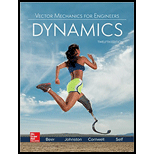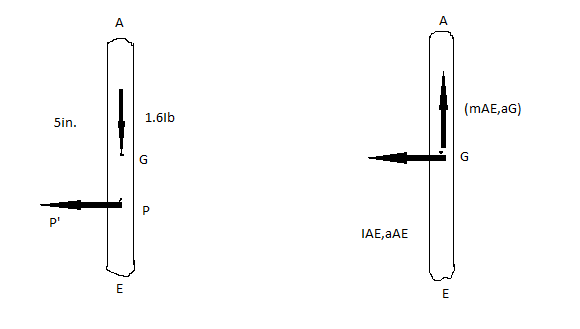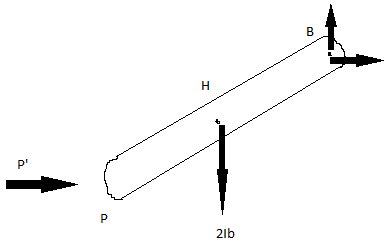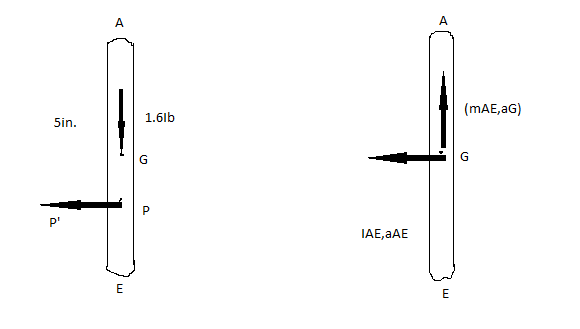
Concept explainers
Two rotating rods in the vertical plane are connected by a slider block P of negligible mass. The rod attached at A has a weight of 1.6 1b and a length of 8 in. Rod BP weighs 2 lb and is 10 in. long and the friction between block P and AE is negligible. The motion of the system is controlled by a couple M applied to rod BP. Knowing that rod BP has a constant angular velocity of 20 rad/s clockwise, determine (a) the couple M, (b) the components of the force exerted on AE by block P.

(a)
Find a couple of M.
Answer to Problem 16.141P
The couple of M=5.82Ib.in
Explanation of Solution
Given information:
The attached rod A weight is=1.6Lb
And length is=8in.
Rod BP weighs=2Lb
Length is=10in.
Explanation:
First consider the unit vector along the axis of X and Y direction.
So, we have to find the vertical distance from point P and point A(y).
Determine the horizontal distance from point A to B(X)
Here we take the coordinate points as (0,-0.4166ft)
Then the position of the vector
Coordinate points of the point P with the point B is (-0.7216ft,-0.4166ft)
Then the position vector is
Then the coordinate points with the point P and point E as (0,-8/12ft)
Position vector is
Here, the unit vector k as angular direction in clock wise as negative and it is positive when counter clockwise.
Angular velocity of the rod BP in vector form is,
Velocity of the rod BP is,
Formulate the velocity equation of point P
Compare the I terms from equation (1) And (2)
Compare the equation (1) and (2) for j terms
So, the angular acceleration is zero.
Formulate the acceleration of the rod BP
Find the acceleration of the point P to the point E
Formulate the acceleration at the point P
Substitute the above values
Based on equations (3) and (4), we get,
Find the mass of the rod AE
Then the moment of inertial of the rod AE is
Similarly find the mass of the rod BP
Then the moment of inertial of the rod BP is,
Here, the mass of the centers of rod AE and BP are to be considered as G and H
Then the reference for point G with point A as (0,-4/12ft).
Here, the position vector is −(0.3333ft)j.
Similarly, the point H with point B as the reference as (-0.7216ft,-0.4166ft) position vector is −(0.7216ft)i-(0.4166ft)j.
Acceleration of the point G is get by
Find the acceleration at point H

Considering the above diagram take the moment about point A

Based on above figure consider the moment about point B
Substitute the values
The magnitude of the couple applied on the rod is BP. It is considered as 5.82Ib.ft acts in a clockwise direction.
(b)
Find the force exerted on rod AE.
Answer to Problem 16.141P
The force exerted by rod AE is F=12.240Ib
Explanation of Solution

Considering the above diagram take the moment about point A
The force exerted by rod AE by block P is 12.240Ib. It is acted upon the left direction.
Want to see more full solutions like this?
Chapter 16 Solutions
VECTOR MECH...,DYNAMICS(LOOSE)-W/ACCESS
- My ID#016948724 please solve this problems and show me every step clear to follow pleasearrow_forwardMy ID# 016948724arrow_forwardPlease do not use any AI tools to solve this question. I need a fully manual, step-by-step solution with clear explanations, as if it were done by a human tutor. No AI-generated responses, please.arrow_forward
- Please do not use any AI tools to solve this question. I need a fully manual, step-by-step solution with clear explanations, as if it were done by a human tutor. No AI-generated responses, please.arrow_forwardPlease do not use any AI tools to solve this question. I need a fully manual, step-by-step solution with clear explanations, as if it were done by a human tutor. No AI-generated responses, please.arrow_forward[Q2]: The cost information supplied by the cost accountant is as follows:Sales 20,00 units, $ 10 per unitCalculate the (a/ newsale guantity and (b) new selling price to earn the sameVariable cost $ 6 per unit, Fixed Cost $ 30,000, Profit $ 50,000profit ifi) Variable cost increases by $ 2 per unitil) Fixed cost increase by $ 10,000Ili) Variable cost increase by $ 1 per unit and fixed cost reduces by $ 10,000arrow_forward
- can you please help me perform Visual Inspection and Fractography of the attatched image: Preliminary examination to identify the fracture origin, suspected fatigue striation, and corrosion evidences.arrow_forwardcan you please help[ me conduct Causal Analysis (FTA) on the scenario attatched: FTA diagram which is a fault tree analysis diagram will be used to gain an overview of the entire path of failure from root cause to the top event (i.e., the swing’s detachment) and to identify interactions between misuse, material decay and inspection errors.arrow_forwardhi can you please help me in finding the stress intensity factor using a k-calcluator for the scenario attathced in the images.arrow_forward
 Elements Of ElectromagneticsMechanical EngineeringISBN:9780190698614Author:Sadiku, Matthew N. O.Publisher:Oxford University Press
Elements Of ElectromagneticsMechanical EngineeringISBN:9780190698614Author:Sadiku, Matthew N. O.Publisher:Oxford University Press Mechanics of Materials (10th Edition)Mechanical EngineeringISBN:9780134319650Author:Russell C. HibbelerPublisher:PEARSON
Mechanics of Materials (10th Edition)Mechanical EngineeringISBN:9780134319650Author:Russell C. HibbelerPublisher:PEARSON Thermodynamics: An Engineering ApproachMechanical EngineeringISBN:9781259822674Author:Yunus A. Cengel Dr., Michael A. BolesPublisher:McGraw-Hill Education
Thermodynamics: An Engineering ApproachMechanical EngineeringISBN:9781259822674Author:Yunus A. Cengel Dr., Michael A. BolesPublisher:McGraw-Hill Education Control Systems EngineeringMechanical EngineeringISBN:9781118170519Author:Norman S. NisePublisher:WILEY
Control Systems EngineeringMechanical EngineeringISBN:9781118170519Author:Norman S. NisePublisher:WILEY Mechanics of Materials (MindTap Course List)Mechanical EngineeringISBN:9781337093347Author:Barry J. Goodno, James M. GerePublisher:Cengage Learning
Mechanics of Materials (MindTap Course List)Mechanical EngineeringISBN:9781337093347Author:Barry J. Goodno, James M. GerePublisher:Cengage Learning Engineering Mechanics: StaticsMechanical EngineeringISBN:9781118807330Author:James L. Meriam, L. G. Kraige, J. N. BoltonPublisher:WILEY
Engineering Mechanics: StaticsMechanical EngineeringISBN:9781118807330Author:James L. Meriam, L. G. Kraige, J. N. BoltonPublisher:WILEY





